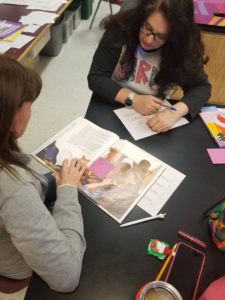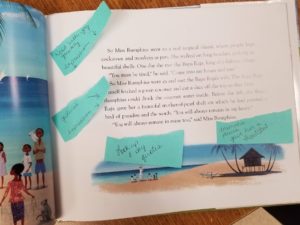The title of the show presents itself in the next line of the song. We hear of “A Reading Rainbow” that promises readers we can go anywhere and be anything.
When Reading Rainbow® aired in 1983, it was in response to research being published around the summer reading loss phenomena. Public Broadcast Service (PBS) wanted to create a show that would provide students access to reading experiences during the summer months. Twila Liggett, co-creator and executive producer of Reading Rainbow® said, “I wanted to do something to mirror what I did in the classroom, which was read to kids out loud, get kids involved in the experience of reading, and have kids talk to each other about reading. Those became the three basic elements of Reading Rainbow®” (Rossen, 2017).
Within a short time, the show became part of PBS’s yearlong television programming and was embedded into classrooms across the United States. As a student in one of those classrooms, I remember the feeling of being invited into the reading experience by host Levar Burton. I remember the magic of having books read aloud and the interaction between the host and me, his audience. I did believe I could go anywhere because the books were a passport to faraway places and a lens into myself.
Why the Read-Aloud?
Hearing books read aloud has that effect. In her TEDxYouth talk Why We Should All Be Reading Aloud to Children, Rebecca Bellingham, a teacher and literacy consultant (among other things) shares that “…reading aloud gives kids a special kind of access to the transformative power of story, and the experience of what real reading is all about, which is to deeply understand, to think, to learn and discuss big ideas about the world, about the lives of others and about ourselves.”
In a classroom, we can imagine a teacher gathering students around her/him and inviting students to sit comfortably on a reading carpet or ease restfully into a bean bag. The teacher reveals a picture book and begins the artful process of inviting the students into the reading experience. We would expect to see and hear the teacher decoding those tricky words and pausing to ask questions, all while performing with voice, tone, and actions. This intentionality to artfully reading aloud, allows, as Bellingham notes from an interaction with one of her students, to “get inside a book” (2015). And haven’t we all had that experience of getting inside a book.
Why Our Students Don’t Outgrow a Read-Aloud
 As students move up in grades, these experiences become fewer and fewer. As students grow up, they move off the reading carpets. As students grow up, fewer images accompany the pages they may hear read aloud. Yet, Meghan Cox Gurdon, in her book “The Enchanted Hour” blends research and experience to advocate for why reading aloud to students from books with illustrations should continue up the grades. Citing a Cincinnati Children’s Reading and Literacy Discovery Center research from 2017, she notes that MRI imaging showed statistically significant brain activity when children listen to books AND see the illustrations (Gurdon, 2019). She notes that a child’s listening comprehension level is higher than his/her reading comprehension level and his/her reading comprehension will not catch up until the eighth grade (Gurdon, 2019). Therefore, all students, regardless of grade, would benefit from having pictures books read aloud using an artful AND standards-based approach. To help teachers craft their artfulness of reading aloud from books that support the rigor of the learning objectives, books, such as “The Artful Read-Aloud: 10 Principles to Inspire, Engage, and Transform Learning,” have been written as educational resources for teachers.
As students move up in grades, these experiences become fewer and fewer. As students grow up, they move off the reading carpets. As students grow up, fewer images accompany the pages they may hear read aloud. Yet, Meghan Cox Gurdon, in her book “The Enchanted Hour” blends research and experience to advocate for why reading aloud to students from books with illustrations should continue up the grades. Citing a Cincinnati Children’s Reading and Literacy Discovery Center research from 2017, she notes that MRI imaging showed statistically significant brain activity when children listen to books AND see the illustrations (Gurdon, 2019). She notes that a child’s listening comprehension level is higher than his/her reading comprehension level and his/her reading comprehension will not catch up until the eighth grade (Gurdon, 2019). Therefore, all students, regardless of grade, would benefit from having pictures books read aloud using an artful AND standards-based approach. To help teachers craft their artfulness of reading aloud from books that support the rigor of the learning objectives, books, such as “The Artful Read-Aloud: 10 Principles to Inspire, Engage, and Transform Learning,” have been written as educational resources for teachers.
In another such book “The Power of Picture Books: Using Content Area Literature in Middle School,” the authors make a case that picture books in the middle grades are a means to meet national or state content standards while engaging our students with the topics of the content (Fresch & Harkins, 2009). In CTL’s work with PreK-middle school teachers, our Artful Reading program supports teachers in identifying rich picture books that lend themselves to such learning experiences. A sampling of our texts include “Blueberries for Sal”, “Iggy Peck Architect”, “Henry’s Freedom Box”, “Invisible Boy” and “On a Beam of Light.” Inside these modules, teachers explore ways to artfully read aloud, using the texts as a catalyst to engage students around national literacy standards and the National Core Arts Standards.
Looks Like. Sounds Like. Feels Like.
 The professional learning teachers receive includes time to read the texts included in their modules and make connections to their English Language Arts standards. They embed questions they will pause to ask during the real-aloud that are aligned to these standards. The professional learning also engages teachers in using rubrics for their own professional reflection. As part of the work we do with teachers, we ask teachers to use a rubric to self-evaluate and then receive feedback from peers as they work through the process of refining their practice and delivering an artful read-aloud. The criteria include varying speed to match the action(s) of the story, varying tone to match the mood of the story, varying voice to match the physical description(s) of the character(s), and using movement to illustrate actions and vocabulary. Because reading aloud artfully doesn’t just happen; reading aloud artfully takes practice.
The professional learning teachers receive includes time to read the texts included in their modules and make connections to their English Language Arts standards. They embed questions they will pause to ask during the real-aloud that are aligned to these standards. The professional learning also engages teachers in using rubrics for their own professional reflection. As part of the work we do with teachers, we ask teachers to use a rubric to self-evaluate and then receive feedback from peers as they work through the process of refining their practice and delivering an artful read-aloud. The criteria include varying speed to match the action(s) of the story, varying tone to match the mood of the story, varying voice to match the physical description(s) of the character(s), and using movement to illustrate actions and vocabulary. Because reading aloud artfully doesn’t just happen; reading aloud artfully takes practice.
Artful Reading is a program designed by literacy and arts specialists that reflects mindful text selections that will stir conversation and emotions. Students explore the topics of friendship, anti-bullying, empathy, acceptance, diversity, perseverance, and many more. Reading about such topics in a safe classroom setting is important to the well-being of our students. Through research, we know that neurochemicals release when we read close to and with people we love that reduce both stress and anxiety (Gurdon, 2019). The intimacy of a read-aloud can help the students and teacher explore these topics through a safe progression, regardless of grade. The “right” picture book has the power to connect students and content at an affective level (Fresch & Harkins, 2009).
There are many quality books to choose from and Scholastic offers a recommended list of 100 Best Read-Aloud Books. This is not a comprehensive list; there are many others that could be added. Some books lend themselves better to a read-aloud than others. In “Jim Trelease’s Read-Aloud Handbook”, we’re given considerations to keep in mind choosing books to read aloud. Some of those are selecting books we, ourselves, enjoy reading; giving ourselves permission to stop reading a book if it becomes clear after reading that it’s a poor choice; and picking a book that is less familiar to students (Trelease, Trelease, & Giorgis, 2019). But the first step is to select the book. In Chapter 2 of “Best Ever Literacy Survival Tips: 72 Lessons You Can’t Teach Without,” tips are suggested to plan for a read-aloud. One lesson is for the teacher to set aside a consistent time and place slot of 15-20 minutes per day to read aloud. Carving out uninterrupted time sends the message to our students that reading is valued (Trelease, Trelease, & Giorgis, 2019). Another lesson of the 72 is that 15-20 minutes is a recommendation and it is okay to break the rules and read more (Oczkus, 2012).
Be responsive to how your students are reacting to the time together. You may find 15-20 minutes is not long enough and they are craving more time to interact with a text during the read-aloud. When a teacher meets this request for a second and then third read, vocabulary acquisition increases by 15 to 40 percent (Trelease, Trelease, & Giorgis, 2019).
I remember hearing Levar Burton signing off at the end of the Reading Rainbow® episodes with a see you next time and craving another episode and wanting to hear and see MORE picture books read aloud. Reading aloud is magical in that way!
References
Fresch, M. J., & Harkins, P. (2009). The power of picture books: using content area literature in middle school. Urbana, IL: National Council of Teachers of English.
Gurdon, M. C. (2019). The Enchanted Hour. Piatkus Books.
Oczkus, L. D. (2012). Best ever literacy survival tips: 72 lessons you cant teach without. Newark, DE: International Reading Association.
Rossen, J. (2017, May 19). Take a Look: An Oral History of Reading Rainbow. Retrieved from https://www.mentalfloss.com/article/93884/take-look-oral-history-reading-rainbow
Trelease, J., Trelease, J., & Giorgis, C. (2019). Jim Treleases read-aloud handbook (8th ed.). New York: Penguin Books.
(2015, December 29). Why we should all be reading aloud to children: Rebecca Bellingham: TEDxYouth@BeaconStreet. Retrieved from https://youtu.be/ZBuT2wdYtpM
